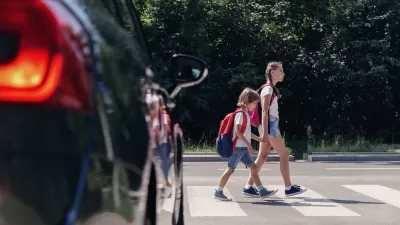Road fatalities fell by a meager 4 percent in the first half of 2023.

According to a press release from the Governors Highway Safety Association (GHSA), pedestrian deaths in the United States dropped by 4 percent in the first half of 2023, but remain 19 percent higher than in 2019 before the pandemic began.
The rise in pedestrian deaths is even more stark when looking back at the past decade – fatalities have risen a staggering 58% between the first half of 2013 and 2023.
The GHSA report attributes the rise in deaths to a steep drop in traffic enforcement, road designs that prioritize fast-moving traffic, and a lack of adequate pedestrian infrastructure in many U.S. cities. “To help address this pedestrian safety crisis, GHSA supports a holistic solution rooted in the Safe System approach that is outlined in the U.S. Department of Transportation’s National Roadway Safety Strategy (NRSS). Each of the five elements of this approach – safe road users, safe vehicles, safe speeds, safe roads and post-crash care – combine to create a multi-layered safety net that can protect people inside and outside of vehicles.”
In a related article in Streetsblog USA, Kea Wilson argues that a Safe Systems approach is necessary but not sufficient to end pedestrian deaths. Wilson writes, “the particular “Safe Systems” that America is building are nowhere near sufficient to meet the scale of our roadway crisis.” Further, “We have not yet meaningfully reckoned with which layers of that system have the most potential to save lives, and which ones are most subject to failure,” nor directed the appropriate resources to strengthening the most effective tools. “And we certainly have not acknowledged that all these endless safety nets just aren’t as necessary when Americans are less dependent on cars to meet their every need, or the essential role that simply having fewer drivers can play in preventing driver violence.”
FULL STORY: U.S. Pedestrian Deaths Fall Slightly in First Half of 2023, but Remain Above Pre-Pandemic Levels

Alabama: Trump Terminates Settlements for Black Communities Harmed By Raw Sewage
Trump deemed the landmark civil rights agreement “illegal DEI and environmental justice policy.”

Planetizen Federal Action Tracker
A weekly monitor of how Trump’s orders and actions are impacting planners and planning in America.

The 120 Year Old Tiny Home Villages That Sheltered San Francisco’s Earthquake Refugees
More than a century ago, San Francisco mobilized to house thousands of residents displaced by the 1906 earthquake. Could their strategy offer a model for the present?

LA’s Tree Emergency Goes Beyond Vandalism
After a vandal destroyed dozens of downtown LA trees, Mayor Karen Bass vowed to replace them. Days later, she slashed the city’s tree budget.

Sacramento Leads Nation With Bus-Mounted Bike Lane Enforcement Cameras
The city is the first to use its bus-mounted traffic enforcement system to cite drivers who park or drive in bike lanes.

Seattle Voters Approve Social Housing Referendum
Voters approved a corporate tax to fund the city’s housing authority despite an opposition campaign funded by Amazon and Microsoft.
Urban Design for Planners 1: Software Tools
This six-course series explores essential urban design concepts using open source software and equips planners with the tools they need to participate fully in the urban design process.
Planning for Universal Design
Learn the tools for implementing Universal Design in planning regulations.
Ada County Highway District
Clanton & Associates, Inc.
Jessamine County Fiscal Court
Institute for Housing and Urban Development Studies (IHS)
City of Grandview
Harvard GSD Executive Education
Toledo-Lucas County Plan Commissions
Salt Lake City
NYU Wagner Graduate School of Public Service





























